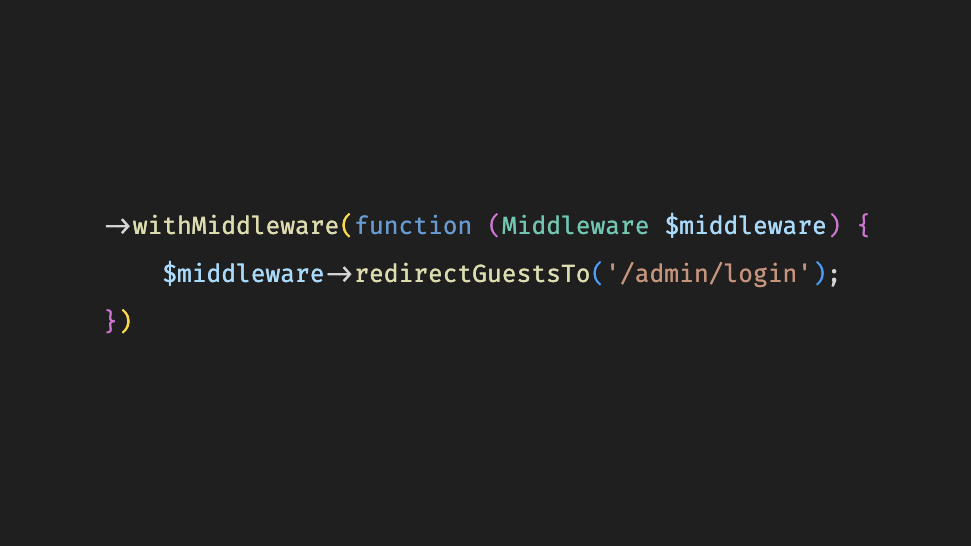
Middleware in Laravel 11 and how to customize them
Introduction to middleware customization in Laravel 11
Starting from Laravel 11, new projects get to experience a slimmer skeleton. Parts of the efforts to make it happen were to remove the default middleware classes.
But how do you customize them then? Easy! Just go into your bootstrap/app.php file and configure them however you want. Let me show you in more detail for the most common use cases.
Customize the most common middleware
Change where guests are redirected
To customize where guests are redirected, use the redirectGuestsTo() method in bootstrap/app.php:
->withMiddleware(function (Middleware $middleware) { $middleware->redirectGuestsTo('/admin/login'); })
Previously, this was happening in the Authenticated.php middleware file.
Change where users and guests are redirected
To customize where users and guests are redirected, use the redirectTo() method in bootstrap/app.php:
->withMiddleware(function (Middleware $middleware) { $middleware->redirectTo( guests: '/admin/login', users: '/dashboard' ); })
Previously, this was happening in the Authenticated.php and RedirectIfAuthenticated.php middleware files.
Exclude cookies from being encrypted
To customize which cookies must not be encrypted, use the encryptCookies() method in bootstrap/app.php:
->withMiddleware(function (Middleware $middleware) { $middleware->encryptCookies(except: [ 'foo', 'bar', ]); })
Previously, this was happening in the EncryptCookies.php middleware file.
Exclude routes from CSRF protection
To customize which routes must be excluded from CSRF protection, use the validateCsrfTokens() method in bootstrap/app.php:
->withMiddleware(function (Middleware $middleware) { $middleware->validateCsrfTokens(except: [ '/foo/*', '/bar', ]); })
Previously, this was happening in the VerifyCsrfToken.php middleware file.
Exclude routes from URL signature validation
To exclude routes from URL signature validation, use the validateSignatures() method in bootstrap/app.php:
->withMiddleware(function (Middleware $middleware) { $middleware->validateSignatures(except: [ '/api/*', ]); })
Previously, this was happening in the ValidateSignature.php middleware file.
Prevent converting empty strings in requests
To configure the middleware that converts empty strings to null, use the convertEmptyStringsToNull() method in bootstrap/app.php:
->withMiddleware(function (Middleware $middleware) { $middleware->convertEmptyStringsToNull(except: [ fn ($request) => $request->path() === 'foo/bar', ]); })
Previously, you had to remove the ConvertEmptyStringsToNull middleware in the app/Http/Kernel.php file or do it on a per route basis.
Prevent string trimming in requests
To configure the middleware responsible for trimming strings, use the trimStrings() method in bootstrap/app.php:
->withMiddleware(function (Middleware $middleware) { $middleware->trimStrings(except: [ '/foo', ]); })
Previously, this was happening in the TrimStrings.php middleware file.
Advanced middleware customization
In addition to the basic customizations we’ve covered, Laravel 11 offers more advanced options for middleware manipulation. These can be particularly useful for complex applications or when you need fine-grained control over your middleware stack.
Manipulating the global middleware stack
You can add, remove, or replace middleware in the global stack:
->withMiddleware(function (Middleware $middleware) { $middleware->prepend(SomeMiddleware::class); $middleware->append(AnotherMiddleware::class); $middleware->remove(UnwantedMiddleware::class); $middleware->replace(OldMiddleware::class, NewMiddleware::class); })
Working with middleware groups
Laravel allows you to define and modify middleware groups:
->withMiddleware(function (Middleware $middleware) { $middleware->group('custom', [ FirstMiddleware::class, SecondMiddleware::class, ]); $middleware->prependToGroup('web', NewWebMiddleware::class); $middleware->appendToGroup('api', NewApiMiddleware::class); $middleware->removeFromGroup('web', OldWebMiddleware::class); $middleware->replaceInGroup('api', OldApiMiddleware::class, NewApiMiddleware::class); })
API-specific configurations
For API-focused applications, Laravel provides specific methods:
->withMiddleware(function (Middleware $middleware) { $middleware->statefulApi(); // Enable Sanctum's frontend state middleware $middleware->throttleApi('custom_limiter', true); // Configure API rate limiting })
Configuring trusted proxies and hosts
For applications behind a proxy or load balancer:
->withMiddleware(function (Middleware $middleware) { $middleware->trustHosts(['example.com', '*.example.com']); $middleware->trustProxies(['192.168.1.1', '192.168.1.2']); })
Enabling authenticated sessions
To ensure sessions are authenticated in the “web” middleware group:
->withMiddleware(function (Middleware $middleware) { $middleware->authenticateSessions(); })
These advanced options provide more flexibility in customizing your application’s middleware behavior, allowing you to fine-tune security, performance, and functionality as needed.